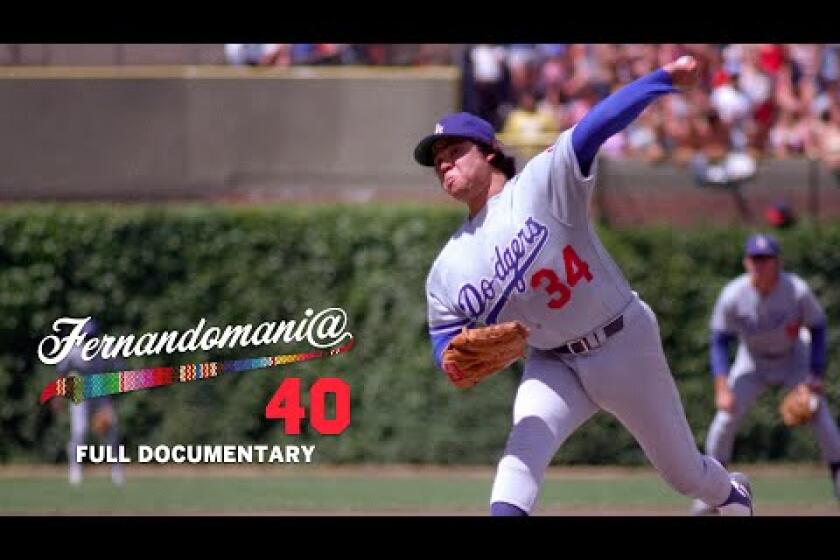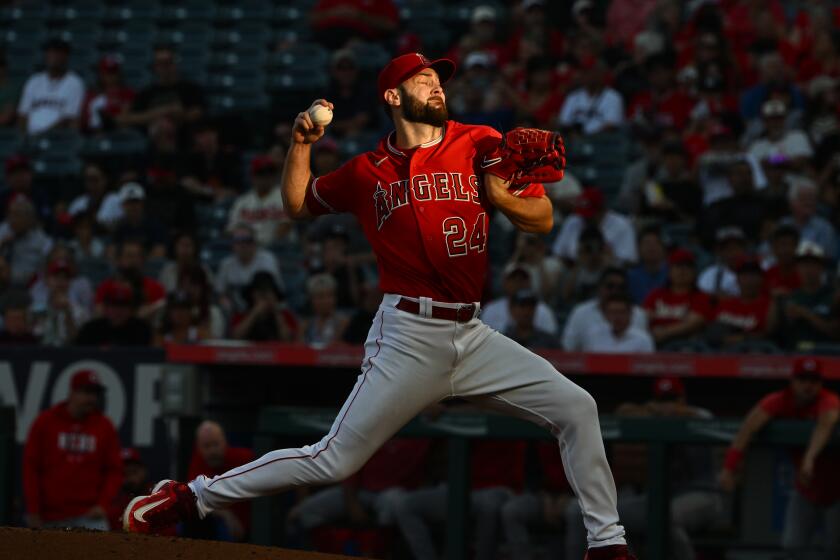Unforgettable Fernando Valenzuela and K-Rod were Dodgers’, Angels’ top September call-ups

- Share via
Fernandomania took hold in 1981. Every Dodgers fan knows that.
Fernando Valenzuela, the rookie left-handed pitcher from Etchohuaquila, Mexico, led the Dodgers to a World Series championship and won Cy Young and Rookie of the Year awards.
But Valenzuela first surfaced at Dodger Stadium the previous September, called up from double-A San Antonio when rosters expanded. He pitched 17 2/3 innings across 10 relief appearances and did not allow an earned run while going 2-0 with one save.
It was a harbinger of excellence to come — Valenzuela opened the 1981 season with 16 scoreless innings and gave up only four earned runs in his first eight starts, all complete-game victories. Fernandomania was in full regalia.
But his debut the previous year makes him the leader in the clubhouse as the greatest September call-up in Dodgers history. A close second would be Corey Seager, who was inserted as starting shortstop upon being called up in 2015 and batted .337 with an on-base-plus-slugging percentage of .986. He had at least one hit in 21 of 27 games and the Dodgers ran away with the National League West title.
Like Valenzuela and the Dodgers, the greatest September call-up in Angels history was a precocious yet dominant arm out of the bullpen: Francisco Rodriguez, a 20-year-old right-hander from Caracas, Venezuela, in 2002.
K-Rod, as he quickly came to be known, needed only 5 2/3 scoreless innings of regular-season work in which he struck out 13 for Angels manager Mike Scioscia to entrust him with a key relief role in the postseason. Rodriguez was 5-1 with 28 strikeouts in 18 2/3 innings and the Angels won their only World Series title.
“One win in the postseason was great, and now I have five,” Rodriguez said after mowing down nine consecutive San Francisco Giants batters in a World Series Game 2 win. “If I’m dreaming, I don’t want to wake up.”
September call-ups historically have given teams an opportunity to audition top prospects or to add reinforcements for a playoff push. Sometimes both.
And occasionally, a promising young player launches a trip to Cooperstown in September. Eventual Hall of Famers from at least 11 teams began as call-ups, and the first might have been Luke Appling, promoted in 1930 and beginning a 20-year career with the Chicago White Sox. Yogi Berra was a New York Yankees call-up in 1946, Stan Musial a St. Louis Cardinals call-up in 1941 and Brooks Robinson a Baltimore Orioles call-up in 1955.
‘Fernandomania @ 40’ is a multi-episode documentary series that examines star pitcher Fernando Valenzuela’s impact on the Dodgers, Major League Baseball and the Latino community in Los Angeles 40 years ago.
Other Hall of Famers who debuted in September include Willie Stargell with the Pittsburgh Pirates in 1962, Joe Morgan with the Houston Colt 45s in 1963, Alan Trammell with the Detroit Tigers in 1977, Greg Maddux with the Chicago Cubs in 1986, Edgar Martinez with the Seattle Mariners in 1987, Chipper Jones with the Atlanta Braves in 1993 and Roy Halladay with the Toronto Blue Jays in 1998.
Rosters don’t expand like they used to do. Until 2021, teams could call up 15 minor league players, fattening rosters from 25 to as many as 40. Now, though, only two additional players can be added to 26-man rosters Sept. 1 for the duration of the regular season because of a variety of complaints.
Some grumbled that opponents out of the pennant race would field the equivalent of triple-A lineups, while others moaned that a dugout of nearly 40 players gave a manager an unfair advantage. The new rule hasn’t satisfied everyone.
“I don’t think two is enough, and I think 15 is too much because some teams will call up all 15 and some teams will call up four or five,” Houston Astros manager Dusty Baker said. “You’re either out-manned, or you’ll out-man them. We’ve gone from one drastic measure to another one.”
Generous roster expansion did enable the likes of Dick Nen and R.J. Reynolds to etch their names in Dodgers lore.
The Cleveland Guardians claimed three Angels pitchers, and the Cincinnati Reds took outfielder Hunter Renfroe, leaving the Halos with seller’s remorse.
Nen’s only hit as a Dodger was a ninth-inning home run Sept. 18, 1963, that tied the score against the Cardinals. The Dodgers won in 13 innings to complete a sweep that generated momentum toward an NL pennant and World Series championship over the Yankees.
Reynolds was regarded highly enough that he played in every game after being promoted Sept. 1, 1983, but it was a humble bunt 11 days later that made him a hero. Manager Tommy Lasorda had no idea whether Reynolds could get a bunt down when the rookie stepped to the plate with the bases loaded in the ninth inning of a tie game with the Atlanta Braves at Dodger Stadium.
No matter. Lasorda gave the sign and Reynolds executed a suicide squeeze for a walk-off win that extended the Dodgers’ lead over the second-place Braves to three games.
Dodgers call-ups Friday reportedly will be second baseman Kolten Wong and pitcher Emmitt Sheehan. Wong is an 11-year MLB veteran who signed a minor league contract with the Dodgers two weeks ago. Sheehan is a rookie who is 3-1 with a 5.63 ERA with the Dodgers and 4-2 with a 2.43 ERA in the minors this season.
The Angels have five roster spots to fill even before considering expansion to 28 because five players they put on waivers were claimed by other teams.
More to Read
Go beyond the scoreboard
Get the latest on L.A.'s teams in the daily Sports Report newsletter.
You may occasionally receive promotional content from the Los Angeles Times.













